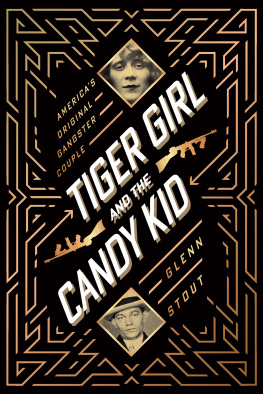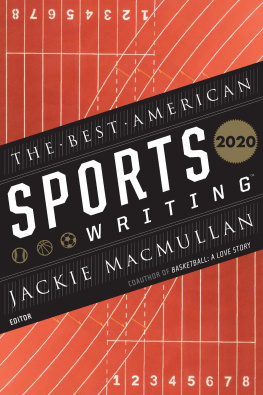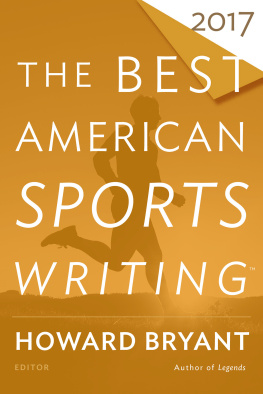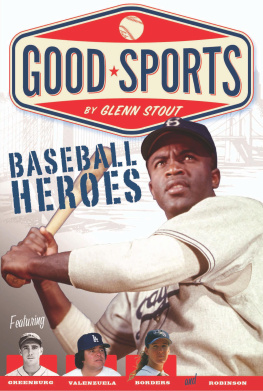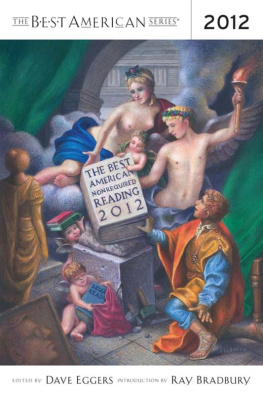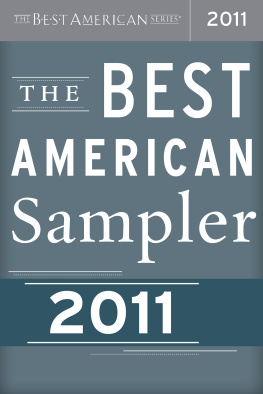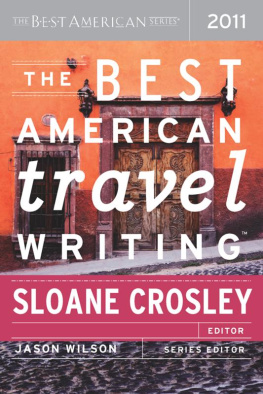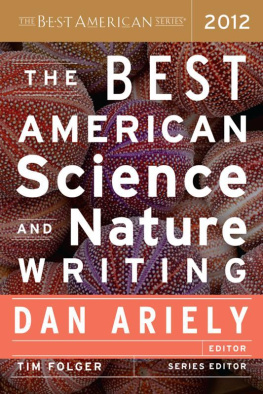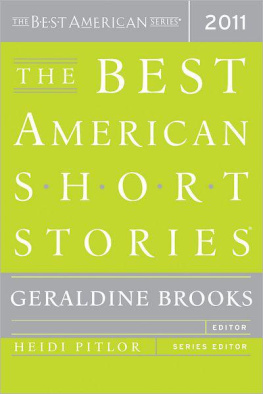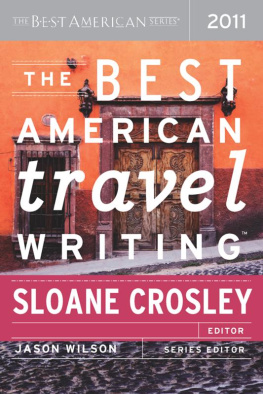Copyright 2012 by Houghton Mifflin Harcourt Publishing Company
Introduction copyright 2011 by Michael Wilbon
ALL RIGHTS RESERVED
The Best American Series is a registered trademark of Houghton Mifflin Harcourt Publishing Company. The Best American Sports Writing is a trademark of Houghton Mifflin Harcourt Publishing Company.
No part of this work may be reproduced or transmitted in any form or by any means, electronic or mechanical, including photocopying and recording, or by any information storage or retrieval system without the prior written permission of the copyright owner unless such copying is expressly permitted by federal copyright law. With the exception of nonprofit transcription in Braille, Houghton Mifflin Harcourt is not authorized to grant permission for further uses of copyrighted selections reprinted in this book without the permission of their owners. Permission must be obtained from the individual copyright owners identified herein. Address requests for permission to make copies of Houghton Mifflin Harcourt material to Permissions, Houghton Mifflin Harcourt Publishing Company, 215 Park Avenue South, New York, New York 10003.
www.hmhbooks.com
ISSN 1056-8034
ISBN 978-0-547-33697-8
e ISBN 978-0-547-84053-6
v1.1012
The Two-Fisted, One-Eyed Misadventures of Sportswritings Last Badass by Alex Belth. First published in Deadspin.com, December 6, 2011. Copyright 2011 by Alex Belth. Reprinted by permission of Alex Belth.
Punched Out by John Branch. From The New York Times, December 4, 5, 6, 2011, 2011 The New York Times. All rights reserved. Used by permission and protected by the Copyright Laws of the United States. The printing, copying, redistribution, or retransmission of this Content without express written permission is prohibited.
The Shame of College Sports by Taylor Branch. First published in The Atlantic, October 2011. Copyright 2011 by Taylor Branch. Reprinted by permission of Taylor Branch.
Franks Story by John Brant. First published in Runners World magazine, October 2011. Copyright 2011 by John Brant. Reprinted by permission of John Brant.
Fixing Dianes Brain by Bill Donahue. First published in Runners World magazine, February 2011. Copyright 2011 by Rodale Inc. Reprinted by permission of Rodale Inc. and William F. Donahue.
Fallen Star by Robert Huber. First published in Philadelphia Magazine, January 2011. Copyright 2011 by Metro Corp. Reprinted by permission of Metro Corp.
Bad Nights in the NFL by Thomas Lake. First published in Sports Illustrated, April 11, 2011. Reprinted courtesy of Sports Illustrated. Copyright 2011, Time Inc. All rights reserved.
The People v. Football by Jeanne Marie Laskas. First published in GQ, March 2011. Copyright 2011 by Jeanne Marie Laskas. Reprinted by permission of Jeanne Marie Laskas.
The Forgotten Hero by Tim Layden. First published in Sports Illustrated, November 7, 2011. Reprinted courtesy of Sports Illustrated. Copyright 2011, Time Inc. All rights reserved.
Boy Genius by Jer Longman. From The New York Times, May 22, 2011, 2011 The New York Times. All rights reserved. Used by permission and protected by the Copyright Laws of the United States. The printing, copying, redistribution, or retransmission of this Content without express written permission is prohibited. He Doesnt Live There, a collection of Ray Hudson quotes arranged by Bob Lalasz, used by permission.
Queen of the D-League by Ben McGrath. First published in The New Yorker, April 25, 2011. Copyright 2011 by Ben McGrath. Reprinted by permission of the author.
The History (and Mystery) of the High Five by Jon Mooallem. First published in ESPN: The Magazine, August 8, 2011. Copyright 2011 by ESPN, Inc. Reprinted by permission of ESPN: The Magazine.
He Do What He Do by Michael Mooney. First published in D Magazine, April 2011. Copyright 2011 by Michael Mooney. Reprinted by permission of the author.
The Heart of Football Beats in Aliquippa by S. L. Price. First published in Sports Illustrated, January 31, 2011. Staring Down History by S. L. Price. First published in Sports Illustrated, May 23, 2011. Reprinted courtesy of Sports Illustrated. Copyright 2011, Time Inc. All rights reserved.
The Phenomenal Son by Dave Sheinin. First published in The Washington Post Magazine, March 13, 2011. Copyright 2011 by The Washington Post. Reprinted by permission of The Washington Post.
The Ferocious Life and Tragic Death of a Super Bowl Star by Paul Solotaroff with Rick Telander. First published in Mens Journal, May 2011. Copyright 2011 by Paul Solotaroff. Reprinted by permission of the author.
Why You Should Care about Cricket by Wright Thompson. First published on ESPN.com, April 7, 2011. Copyright 2012 by ESPN.com Reprinted by permission of ESPN.com.
Something Went Very Wrong at Toomers Corner by Tommy Tomlinson. First published in Sports Illustrated, August 15, 2011. Reprinted courtesy of Sports Illustrated. Copyright 2011, Time Inc. All rights reserved.
Welcome to the Far Eastern Conference by Wells Tower. First published in GQ, May 2011. Copyright 2011 by Wells Tower. Reprinted by permission of The Wylie Agency, LLC.
Foreword
H ERES HOW IT GOES:
On most days I rise early5:30 A.M. , 6:00 A.M. just after my wife and before my daughter wakes for school. While they get ready I drink coffee, maybe tea, feed the dog, check the weather, glance over e-mails. And when they leave I go down to the basement office I built eight years ago, the one with two desks, two windows, shelves of books, and piles and boxes of paper everywhere, a place where the shades are always drawn so the room is always the same and distractions fade.
This is where I write, almost every day, something. A column for a magazine. A chapter for a title in my juvenile series Good Sports, a note for my blog, a tweet, or something for one of my other, larger projects that sometimes occupy me for two, three, even four years at a time, require weeks in libraries, hours taping interviews, months searching online, all the time accumulating facts and details and feelings. Words by the dozen become hundreds, and thousands become millions.
I like working early, writing early, getting it out of the way before the details of life intrude. I do not understand people who work and write at the end of the day, when what has just happened is still at issue. By evening my eye is tired, my mind full.
Friends sometimes telephone. M. calls to talk about baseball, concrete, cycling, music, politics, and art. R. has a question, passes along a tip, parries my rants with his own. H. buries the lede, tells a story, answers a query, and in the end we talk about writing and writers, books and words, and how we do this every day.
On good days I stop by noon, or one oclock or two. I can write for longer periods of time, but less efficientlyafter five or six hours the flow ebbs and I sink, each new word written coming slow. So I take the dog outside, throw the ball, walk through the woods, and miss the one that left us last year. Sometimes we walk all the way back to the lake, to the cabin I built that floats in the swamp, just offshore, hidden in the brush. Summer nights I sleep inside and listen to the beaver gnawing on the willows 15 feet away. Then I wake before the dawn, sit in a kayak on the lake in the dark, and watch the mist and sun rising together. Winters I ski across it on the ice, aiming for the opposite shore.
We walk back home, looking for deer sign, coyote tracks, and scat. Then I climb into the truck, bounce the long quarter-mile down my gravel driveway, turn onto the road, and drive to the post office in town five minutes away.
Next page

